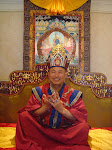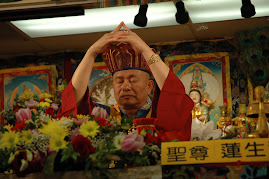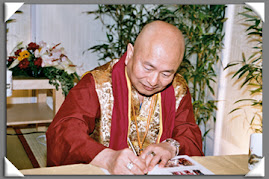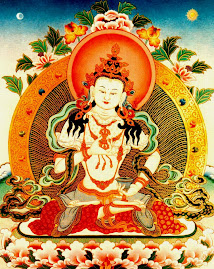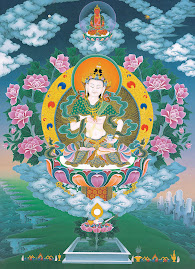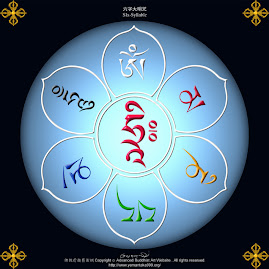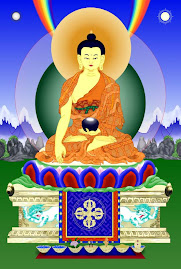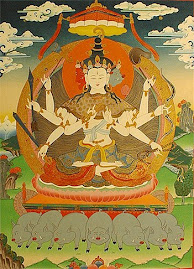
VAJRABHAIRAVA YAMANTAKA:
A TANTRIC INITIATORY VISION
"The secret of the body is Vairochana and the Dhyani Buddhas;
The secret of speech is Locana and the Buddha consorts;
The secret of the mind is Yamantaka and the Wrathful Ones."
(Ratnakarashanti)
The form of Yamantaka represented here is known as Ekavira, the "Solitary Hero". The Sanskrit term Vajrabhairava means the "Adamantine Terrifier" and Yamantaka means "Remover of the Obstacle Yama (the Judge of the Dead)."
This impressive sculpture, done in wood and finished with multi-colored lacquer, has a height of 52.25 inches (132 cms). Collected by the American artist George Grey Barnard, in
Immediately following Kublai Khan's becoming Supreme Emperor, Karma Pakshi (1204-1283) the second Karmapa hierarch traveled to
THIS TANTRIC VISION
This 34-armed, 16-legged awesome form of Ekavira Vajrabhairava Yamantaka has a central bulls head with long black horns and the body colored deep dark blue-black. The main and largest head wears a tiara of human skulls surmounted by an elaborate five-fold gilded crown embellished with the Buddhist "Wheel of Law" motif. Above, the hair stands on end and is treated much like the style seen in Mahakala images - "with scorpion-sting shaped tips." The mouth is open wide to reveal teeth, a lolling tongue and large red lips. The eyes are large, protruding and blood-shot, a "third eye" located at the center of the forehead. The eyebrows are angrily knitted and elaborately raised and gilded. In total there are eight main heads - a yellow one to the proper right, a red one to the left, followed by others of pink, white/grey and blue - plus a ninth small crowned red head of the Bodhisattva Manjusri at the apex. These nine heads are in Tantric texts, linked to the nine classic "sentiments."
The central main hands of the deity hold a chopping-knife (karttrka) and human skull-bowl (kapala), colored gold and ornamented by pearl chains, flammiforms and scepters (vajra). The lower main hands hold a magical knife (purba) and the severed multi-faced head of Brahma the Creator. The upper main hands hold a red right hand holding an arrow and an elaborately decorated golden shield with a Chinese-style makara or dragon face at the center. The other hands hold a ritual scepter (vajra), lance, axe, double-drum (damaru), Wheel of Law (dharmachakra), dagger, swirling flames, ritual bell (ghanta), skeleton-staff (khatvanga), banner, a red human right foot, a transfixed corpse, various magical knives and stakes, a noose, a skin, and other Tantric weapons.
The deity wears snake-bracelets, an elaborate chain and pearl motif looped necklace, armbands, an intricate draped girdle, anklets and other Dharmapala ornaments done in a style normally seen in the Yongle-period bronzes of Yamantaka and Mahakala. Everywhere the decoration, done in raised gilded lacquer and/or wood, is lavishly finished. A garland of human heads of different types and colors is threaded on an iron band draped around the neck of the deity and descending almost to the ankles. Seen from the back and sides, the massivity of this subject is all the more apparent. The layers of legs and arms convey a feeling of hallucinatory exuberance; the pair of legs at the extreme back are off the podium, as if in dance. The main legs are in the alidhasana posture, the row of right legs bent at the knee and the left legs straight. This pose, taken from classical Indian dance, is common in sculpture and dance from
The deity stands on the back of a row of birds (under the proper left foot), animals (a horse, a bull) and a man (under the right foot), and four small figures plus a large bird in obeisance can be seen on the podium. Together, they all represent the "four ancient classes of beings" (birds, animals, humans and gods). The three seated figures are the Hindu "trinity" of gods - a multi-headed Brahma holding an elixir-vase, a single-headed Vishnu and a multi-headed Shiva. The large bird is the Garuda, spiritual vehicle of Vishnu. The human figure on one knee in front of the left foot of the deity almost certainly is the donor king or prince who originally commissioned the icon. He wears a crown and the armor of a Mongol warrior and may be a portrait of Kublai himself.
The lotus podium is of a most unusual type. Generally one sees double lotus podiums, one above the other, and if single, the lotus petals point downwards. The row of single upward-turned lotus petals on the base of this icon go all around. The petals are modeled in the typical early Yuan fashion, with elaborate swirling formalized patterns repeated and the tips of the petals protruding outwards. Each petal has its design raised, embellished and colored. A row of "pearls" of even size encircles the upper part of the podium. The podium top is lacquered Imperial red.
The hands and feet have protruding nails or claws, and an elaborately draped scarf, done in red on the inside and decorated with Imperial gold flowers and foliate motifs, and of dark blue and gold on the outside reaches from behind the head of the deity to just above the feet.
THE MYTHIC BACKGROUND
In ancient Iranian mythology Yima, the first man, is cast out of
In the Upanishads Yama is presented as the "Virile Lord", a little wild perhaps, a "husband of women and lover of maidens", while also serving as "Judge of the Dead". King Yam or "Yam Raj", the "God of Death" of popular Hinduism, is also the Great Instructor into the mysteries of life and the hereafter. Yama is described as being like a dark male buffalo, or in human shape as a dark man riding a male buffalo and holding a club or staff. His domain was supposed to be "in the South". Interestingly, the aboriginal Bhil tribal peoples of
Yama becomes connected to the Bhairava or wrathful form of Shiva in the Hindu Tantric tradition. This form of dread and terror was assumed after Shiva decapitated Brahma the Creator. Brahma's head became Shiva's begging bowl, which finally fell from his hand at
Yama's sister Yami is associated with the sacred river Yamuna, connected to the main Subtle Channel (nadi) on the left, the "Path of Death". She is further associated with Chamunda (the emaciated yogini and Mother Goddess of the cremation-ground) and Durga (the mystic form of Shiva's consort Uma/Parvati/Kali). The eight Bhairava-forms of Shiva (named Krodha, Kapali, Canda, Ruru, Samhari, Asitanga, Bhisana and Unmatta in one tradition) have the eight Mother Goddesses (matrikas) as magical consorts or "sisters", and are further connected to eight Great Cremation-grounds which become the main places for Tantric initiation and are usually depicted around the outer edge of Tantric mandala paintings from Nepal and Tibet, whenever a wrathful form is at the center.
The Hindu rites of Yama are generally supposed to be necromantic and take place at midnight during the dark of the month, in the cremation-grounds. The dark wrathful Yogi of Shaivite style - with hair wild and matted, eyes red and bulging from intoxicants, body covered with funeral ashes, draped in animal skins and snakes, holding a trident and eating from a human skull-bowl - become an icon of initiation, a Mahakala or Bhairava, who can take the seeker through the dark mysteries of death and into the clear light of Self-realization.
The confrontational and spontaneous initiatory approach of the Indian Siddha Yogis has been well documented in history and at the present time. Some Tibetans who had the fortitude and courage to reach
Madanjeet Singh, author of a fine book on Himalayan Art and culture, retells the popular Tibetan story as to how Yamantaka got his bull's head:
"The origin of the bull-head is ascribed to the tradition which speaks of a holy man who lived in a cave, practicing meditation. As he was about to achieve his objective and enter nirvana, two thieves with a stolen bull entered the cave and slaughtered it. When they saw the ascetic, a witness to their crime, they beheaded him too. But to their astonishment, the victim lifted the head of the bull and replacing his own severed head with it, became the ferocious form of Yama. He then not only devoured the two thieves, but his insatiable thirst for human blood threatened the whole population. The followers of the Vajrayana, therefore, appealed to Manjusri who, then assuming the fierce bull-headed form of Yamantaka, defeated Yama in a fearful struggle."
"Yamantaka is an important deity in both the 'old' and 'new' Tantra traditions. The clear and penetrating wisdom of Yamantaka is the slayer of death."
================================================
Buffalo-Head
There was once a yogi who lived in isolation in a cave in the mountains where he practiced meditation with determination. One day, while sitting in profound samadhi and just about to achieve the
When they noticed the ascetic, who would certainly be able to identify them to authorities, they smoothly and swiftly beheaded him, too. The siddha, in a fury that his objective -- so near in that lifetime -- had been thwarted, reached out and grabbed the closer of the heads lying there, and with a twist of his wrist, installed the missing part. It happened to be that of the bull.
Thus, his prior spiritual attainment combined with his anger, frustration and animal fury to cause him to take on the form of the most ferocious of the devas, Lord Yama, God of Death (Chinese: Yen-Lo-Wang.) Having assumed this form he not only slaughtered the two cattle rustlers, but went on a rampage that threatened the population for miles around.
In desperation, followers of the Buddha-dharma appealed to the Great Bodhisattva, Manjushri, for help. Jampel Yang (as Manjusri is known in Tibetan,) having both wisdom and compassion, as well as superior knowledge, used like to conquer like. He assumed a fierce bull-headed form himself and put an end to the furious and mindless predation of that particular version of Yama, the Lord of Death.
---o ---o ---o ---o ---o ---o ---o ---o
As the manifestation of Manjushri, he is shown as black or midnight blue (Karma Kagyu form).
Yamantaka (Defeater of Death) is one of the Drag-ched -- eight Dharmapalas, Protectors of the Teaching of the Buddhas.
| |
Though they are terrifying in appearance they are all bodhisattvas -- embodiments of compassion that can manifest out of Emptiness to act in an extremely wrathful way for the sake of sentient beings.
Also called Yamari (Yama's enemy,) Yamantaka is only one aspect of Vajrabhairava (Absolutely Terrifying,) usually depicted as riding or standing on a bull that is trampling Yama.
Yamantaka: The Conqueror of Death
Yamantaka, the ferocious emanation of Manjushri (Bodhisattva of wisdom), is the most complicated and terrible of all the wrathful Buddhist divinities. Under this from he conquered the demon king of death, Yama, who was depopulating
Yama appears in Indian mythology with the head of a water buffalo. To tame Yama, Manjushri adopted the same form, adding to it eight other faces and a multiple array of arms, each holding fearful and deadly weapons. He further sprouted a corresponding number of legs, and surrounded himself with a vast host of terrifying beings. To confront death, he thus manifested the form of death itself, magnified to infinity. Death (Yama) saw himself endlessly mirrored back to himself, infinitely outnumbered by himself. Death was literally scared to death. Thus the yogi who meditates through the imagery of Yamantaka intends and hopes to develop a sense of identity strong enough to face down death, and the fear that attends upon it. Each head, each limb, each attribute, symbol and ornament of Yamantaka expresses the total mobilization of the faculties of enlightenment needed for this ultimate confrontation.
Both Yama and Yamantaka are represented with bull’s heads, but Yama always has an ornament, shaped like a wheel on his breast, which is his distinctive mark.









